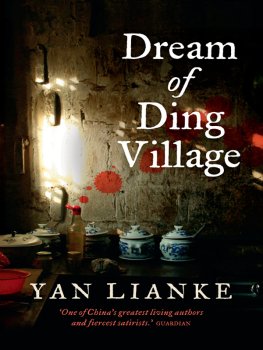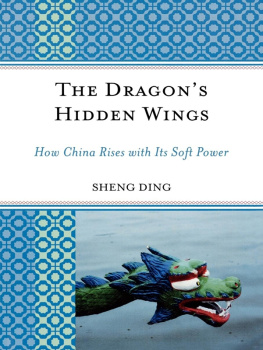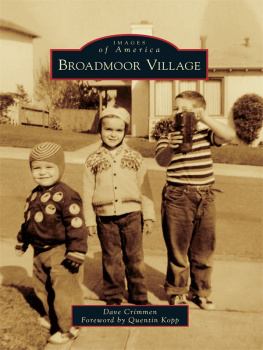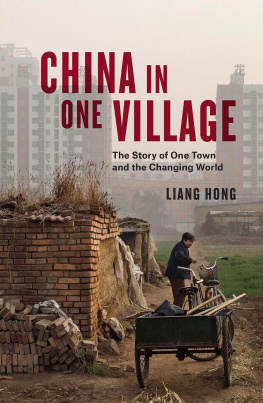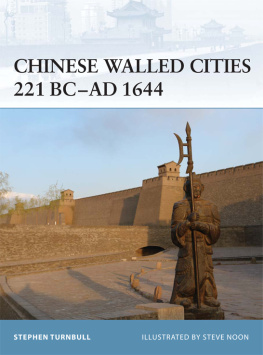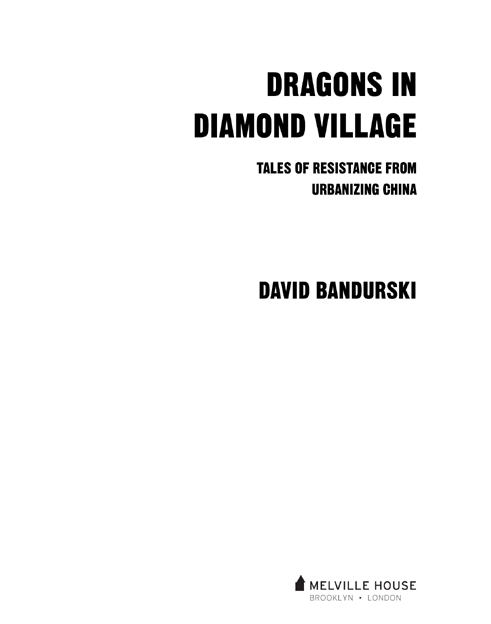DRAGONS IN DIAMOND VILLAGE
Copyright 2016 by David Bandurski
First published by Penguin Group (Australia), 2015
First Melville House Printing: October 2016
Melville House Publishing
46 John Street
Brooklyn, NY 11201
and
8 Blackstock Mews
Islington
London N4 2BT
mhpbooks.com facebook.com/mhpbooks @melvillehouse
Ebook ISBN: 978-1-61219-572-8
v3.1
For Sara and for Tristan
In memory of
Kathryn M. Kozora and Erick Wujcik,
who had such adventures in China
CONTENTS
A NOTE ON SOURCES
All of the stories in this book, and the relationships involved, emerged naturally through the course of the reporting process, a seemingly endless series of trips between Hong Kong and Guangzhou. By naturally, I mean to say that while I was interested from the beginning in urban villages, I never identified relevant stories from a distance, through news coverage or existing scholarship. My focus on the Xian Village saga was, in fact, incidentalthe product of a 2012 visit to the village, long one of my favourites, along with friend and filmmaker Zhao Dayong. Our sole purpose on that visit was to photograph the village, but the more I heard villagers talk about the communitys history and troubles, the more I was enchanted by what Xian seemed to represent. Once I had met Lu Qiang, other sources followed, including Lu Zhaohui and Lu Nianzu, and I circled deeper and deeper into the story. (I should also explain, perhaps, that the surname Lu is an ancient one in Xian Village, along with the surname Xian, which gives the village its present name. Nearly every local in Xian Village is either a Lu or a Xian).
He Jieling, a rights defender from Guangzhous southern Panyu District, found me first, thanks to the wonders of Chinese social mediawhere I remain, as much as possible, a part of Chinas vast conversation. Months after our first meeting in Guangzhou, she introduced me to a group of village-rights defenders, including Huang Minpeng. It was a circuitous path through the stories of He Jieling and Huang Minpeng that eventually led me to Li Qizhong, a villager holed up for months in his tenement home in the citys ancient Yangji Village. I had long assumed, having read Chinese news reports, that Yangji had been completely destroyed. What an unexpected delight it was in 2013 to find, after Huang Minpeng invited me to accompany him on a visit, that the story of Yangji Village was not finished. Inevitably, I came to know many of the sources in this book very well.
PROLOGUE
In 1910, the second year of the reign of the Xuantong Emperor, fighting broke out with Shipai Village over the dragon-boat races and many people in Xian Village died. To prevent further tragedy, the elders of Xian Village decided to suspend dragon-boat racing, and two dragon boats were secretly hidden away.
Xian Village Chronicle
To the Chinese, the dragon is a symbol of courage, perseverance, strength and wisdom, of nation and community, of the endurance of a culture and a people. It is also a self-referential symbol: the Chinese often call themselves the descendants of the dragon. For centuries, the Dragon Boat Festivalknown in Chinese as duanwuwas the main traditional event in many Chinese villages, including Xian Village, in Guangzhou, the capital city of Guangdong Province. The festival was an exhilarating time. Each year, the Xian Villagers joined their Pearl River cousins, or laobiao, and celebrated with dragon-boat paradesfive-day affairs that began with ritual offerings to the dragon spirits overseen by village priests in flowing golden robes. The dragon spirits, embodied in the ornately carved dragon figureheads that adorned the boats, were then marched in noisy procession through the village and out to a nearby waterway, along with shrines to Bei Di, or the Northern Emperor, a god of Chinese mythology revered for his control of the elements. Everyone gathered to watch the spectacle of the boat parades. Some boats carried as many as sixty paddlers pulling in time to the thunder of cow-hide drums, accompanied by the clangour of bronze gongs and smoky salvos of firecrackers that ruptured the air.
For Lu Suigeng, who had served as Xian Villages leader since 1984, and whose immediate family members held nearly all of the other positions of power in the village, the dragon-boat parades were a more ominous gathering. They provided an opportunity for the villagers to come together and, perhaps, unite in opposition to his leadership. Already in 1999 there were rumblings over his secretive management of the villages collectively held assets and lucrative land-use rights deals. The villages farmland had been appropriated for urban development through the 1990s and auctioned off to property developers, and some villagers alleged that Lu Suigengs family had pocketed the transfer fees, totalling the equivalent of tens of millions of dollars.
Lu Suigengs suspicions were warranted. The most popular story of the festivals origins is rooted in resistance to corruption. According to this story, the poet and patriot Qu Yuan of Chinas Warring States Period (475221 BC ) drowned himself in a river to protest corruption so rife it had brought about the downfall of his beloved Chu Kingdom. The races reenact the desperate actions of the fishermen said to have paddled out in vain hopes of saving the poet. In 1999, Lu Suigeng banned the parade.
Still, a decade later, in 2009, Lu Suigengs fears about the Dragon Boat Festival were realized. A decade after Xian Villages last dragon-boat parade, villagers organised in secret to commission three new dragon boats. When the villagers gathered in one of their ancestral halls to donate to the dragon-boat fund, they also made clear their opposition to corruption, signing a petition to be presented to the city leadership.
In 2012, I visited the boat makers workshop, just outside Shangjiao Village, located south of Xian Village across the main arm of the Pearl River. One of the new boats was being stored there. Lu Nianzu, a Xian Villager, described to me the mood on the day when the villagers donated to the fund and signed the petition. It felt like a war recruitment, he said. We all lined up to sign the petition. Everyone was so happy We wanted them to open up the village accounts, and for Lu Suigeng to step down. We signed it one by one, all of us. We put our fingerprints down in red ink next to our signatures. We even provided copies of our identification cards.
On the day of my visit, the boat shone through the midday dusk of the workshop, its hull burnished to pale gold. Lu Zhaohui, another of my Xian Village contacts who, with Lu Nianzu, had accompanied me that day, stepped over to the centre of the streamlined profile, his feet scuffing through the wood shavings scattered across the earthen floor. The body is spruce, he said, running his hand affectionately along the boats polished side. I did not catch the word at first, so he traced the characters with his index finger into the yellow dust of the boat frame, leaving strokes of reddish brown behind: shanmu. The spruce would make the hull strong but lightweight; teak, durable and resistant to corruption, had been used for the frame. It was just the vessel to transport the hopes of the Xian Villagers on their odyssey towards justice.


